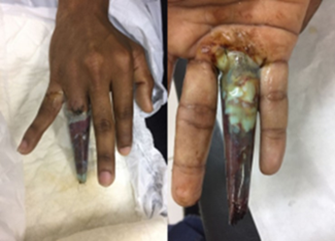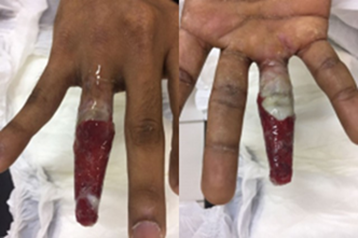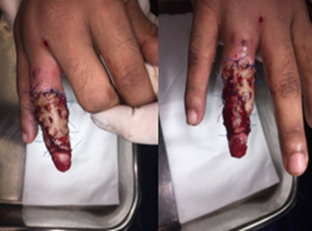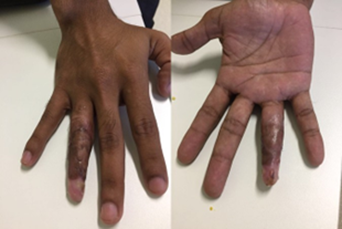Case report
Use of the Figueiredo Technique for The Treatment of Ring Avulsion Injury: A Case Report
- Alessandro Aprecido da Silva Muniz 1
- Matheus Torres Muniz 2
- Leandro Azevedo De Figueiredo 3
- Pedro Hemerly Figueiredo 4
- Bianca Gabriella De Oliveira 5*
1Orthopedist, Hand and Microsurgery Surgeon at Hospital e Pronto Socorro 28 de Agosto, Manaus-AM, Brazil.
2Orthopedic Hand Surgeon and Microsurgery at Hospital das Clínicas de Ribeirão Preto, Ribeirão Preto - SP, Brazil.
3Orthopedic Hand Surgeon and Microsurgery at Apart Hospital Serra, Vitória-ES, Brazil.
4Resident doctor of Orthopedics and Traumatology at Hospital Santa Casa de Misericórdia de Vitória-ES, Brazil.
5Medical Student at the University of Salvador-UNIFACS, Salvador, BA, Brazil.
*Corresponding Author: Bianca Gabriella De Oliveira, Medical Student at the University of Salvador-UNIFACS, Salvador, BA, Brazil.
Citation: A.A.S. Muniz, Matheus T. Muniz, Leandro A. Figueiredo, Pedro H. Figueiredo, Bianca G. Oliveira. (2024). Use of the Figueiredo Technique for The Treatment of Ring Avulsion Injury: A Case Report, Clinical Interventions and Clinical Trials, BioRes Scientia Publishers. 2(2):1-4. DOI: 10.59657/2993-1096.brs.24.015
Copyright: © 2024 Bianca Gabriella de Oliveira, this is an open-access article distributed under the terms of the Creative Commons Attribution License, which permits unrestricted use, distribution, and reproduction in any medium, provided the original author and source are credited.
Received: February 06, 2024 | Accepted: February 21, 2024 | Published: March 26, 2024
Abstract
A Ring Avulsion Injury results from trauma in which the skin of the digit is avulsed, causing exposure of deeper structures, and can be associated with neurovascular, tendon, joint and bone injuries. These injuries are usually severe and present difficulties in choosing the most effective treatment in each case. In order to maintain the digit in these cases, it was necessary to use techniques such as reimplantation or the transfer of flaps for bone coverage, which require a specialized team and a hospital center structured for microsurgical procedures. With this in mind, this study sought to show the results obtained from the treatment of a case of complete Ring Avulsion Injury of the fourth finger of the right hand using the Figueredo Technique (FT). This is a low-complexity, highly effective and low-cost option for repairing injuries with extensive exposure of the soft and bony parts of the phalanges. This avoids amputation of the dislocated area.
Keywords: skin transplantation; soft tissue injuries; microsurgery; orthopedics
Introduction
Avulsion injuries caused by the ring result in avulsion of the skin and subcutaneous tissue of the digit, exposing deeper structures and can be associated with neurovascular, tendon, joint and bone injuries [1,2]. In the traumatized segment, it is common for the circulation of the skin and subcutaneous tissue to be compromised, so it is difficult to accurately determine the viability of that site in order to institute treatment. Thus, Ring Avulsion Injuries represent a major challenge for hand surgeons,with the outcomein most cases being amputation of the digit [3-5]. Given all the difficulties and the lack of clear definitions in the literature regarding the best treatmentoption for theseinjuries, this studyaims to reporton the process and results of treating a case of Ring Avulsion Injury using the Figueiredo Technique (FT) [6].
Case Report
A 23-year-old male patient suffereda complete Ring Avulsion Injury(Urbaniak tipe I) of the 4th finger of his righthand, with no bone damage and exposure of all the flexor and extensor tendons. Extensive surgical debridement was performed to remove devitalized tissue, exhaustive cleaning and application of the Figueiredo Technique (Figure 1).
Figure 1: Application of Figueiredo Technique.
The following day, he was discharged from hospital and released for outpatient follow-up, with the external dressing changed every 10 days. After 33 days, the prosthesis loosened spontaneously (Figure 2).
Figure 2:Mature granulation tissues after loosening the prosthesis.
The patient was readmitted for a new approach and signs of tissue memory were observed, with the formation of skin folds on the affected phalanges and a large amount of granulation tissue, making it feasible to perform a total skin grafton the lesion, using the volar region of the homolateral wrist as the donor area (Figure 3). The patient was discharged from hospital the following day and was advised to return every 10 days for reassessment.
Figure 3: Total skin grafting.
129 days after the trauma, the range of motion in the metacarpophalangeal joint was 90° flexion and 0° extension, in the proximal interphalangeal joint 900° flexion and 00° extension and in the distal interphalangeal joint 400° flexionand 00° extension, with a satisfactory functional result given the severity of the injury (Figure 4).
Figure 4:Final result after treatment
Discussion
Complete ring avulsion injuries are serious and maintaining the digit in these cases required techniques such as replantation or the transfer of flaps for bone coverage [7]. To carry out these procedures, a specialized team and a hospital with an adequate structure for microsurgical procedures are needed, which is not the case in most of Brazil [8,9]. In addition, the severity of the injuries and the exposure of noble tissues such as bones, tendons and vascular-nervous bundles make it difficult to integrate the flaps, often leading to necrosis and treatment failure. Because of these difficulties, surgeons end up opting for amputation of the digit in most cases. The Figueredo Technique, on the other hand, provides low-complexity, highly effective and low-cost treatment for repairing large lesions with extensive exposure of the soft tissue and bone of the phalanges, avoiding amputation of the digit [6]. Another advantage is that it can be performed by any properly trained surgeon/orthopedist, without the need for a professional specializing in microsurgery. The purpose of this new technique is to wrap the entire lesion with a polypropylene prosthesis, a material that is sufficiently resistant to protect the lesion site against painful stimuli and external forces until healing by second intention takes place, but which should not be so rigid as to cause tissue deformities. Therefore, the material that proved to be the most suitable, as it is sterile, low-cost and easily.
accessible in surgical centers throughout the countryman sterile saline bag [6]. The prosthesis should be cut out according to the size and shape of the lesion. The digit should be completely surrounded by the prosthesis, which will have a cone shape once its two ends are joined, and then sutured to the healthy edges of the lesion, forming an occlusive dressing [6]. In this way, as well as providing mechanical protection, the prosthesis prevents the outflow of the exudate formed, which bathes and nourishes the underlying structures, including bones, tendons, vessels and nerves, maintaining their immediate viability. Gradually, this exudate will be replaced by fibrin tissue, with its characteristic yellowish color, which will gradually give way to granulation tissue and lead to total epithelialization of the lesion. This whole process can be observed through the translucent prosthesis, which makes it easier to monitor the healing process. The time it takes for granulation tissue to form varies according to the extent of the lesion, the loss of soft tissue, the presence/absence of an associated infectious process, among other factors inherent to each lesion. In view of this, it is important to periodically reassess the patient.
In the case described, we opted for grafting on mature granulation tissue in a digit recovered from the acute trauma through FT. On the volar side of the lesion, healing occurred more quickly due to the large vascularization of the area, and because of this characteristic, there was complete epithelialization of a larger area under the prosthesis. It is important to emphasize that FT only promotes soft tissue regeneration, so the final length of the digits directly related to bone loss [6]. In cases where there is no bone loss, the original length is maintained in its entirety, with minor deformities depending on the severity of the injury, as occurred in the case above. The functionality of the digit after complete treatment was satisfactory given the severity of the injury. The rehabilitation process is crucial to achieving an arc of movement that is close to normal and that guarantees functionality of the digit, highlighting the importance of physiotherapy. From this perspective, it is possible to conclude that the Figueredo Technique has proved to be a solution for ring avulsion lesions which, to this day, represent a major challenge when it comes to deciding how best to manage them. As such, the technique has established itself as a simple, easy-to-perform, low-cost option with excellent functional and aesthetic results.
Declarations
Conflict Of Interest
The authors declare that they have no conflict of interest.
Financial Support
There was no financial support from public, commercial or non-profit sources.
References
- Pignatti VTP, Cunha MTR, Marinho MAO, Soffner JP, Santos TGM. (2017). Lower limb trauma with degloving: therapeutic options associated with adjuvant hyperbaric oxygen therapy. Cir Case Reports, (1):1-4
Publisher | Google Scholor - Mello DF, Demario LA, Solda SC, Helene Jr A. (2010). Closed degloving: Morel-Lavallée lesion. Rev Bras Cir Plast. 25(2):355-360
Publisher | Google Scholor - Palacio EP, Di Stasi GG, Lima EHR, Mizobuchi RR, Durigam Júnior A. (2015). Results of surgical treatment of Morel-Lavallée lesion. Prospective cohort study. Rev Bras Ortop, 50(2):148-152
Publisher | Google Scholor - Mandel MA. (1981). The management of lower extremity degloving injuries. Ann Plast Surg, 6(1):1-5
Publisher | Google Scholor - Wang ZT, Guo SZ, Xiu ZF, Lu KH, Li QS. (2008). A new model of skin avulsion injuries in rats. Zhonghua Zheng Xing Wai Ke Za Zhi, 24(3):212-215
Publisher | Google Scholor - Figueiredo LA, Ribeiro RS, Melo ALBe, Lima AL, Terra BB. et.al. (2017). Use of polypropylene prosthesis to treat fingertip injuries. Description of surgical technique and results. Rev Bras Ortop, 52(6):685-692
Publisher | Google Scholor - Caetano EB, Almagro MAP, Camargo Neto AA, Franco RM, Santalla TP. (2010). Injuries to the ends of the fingers, the nail and the nail bed. Rev Fac Cienc Med Sorocaba, 12(4):1-5
Publisher | Google Scholor - Simão DT, Mattar Júnior R, Rezende MR, Wei TH, Torres LR. (2012). Reimplantations in amputations by avulsion mechanism: tactics and techniques for success. Acta Ortop Bras, 20(2):104-109
Publisher | Google Scholor - Teixeira Neto N, Chi A, Paggiaro AO, Ferreira CF. (2010). Surgical treatment of complex wounds. Rev Med, 89(3-4):147-151.
Publisher | Google Scholor



















